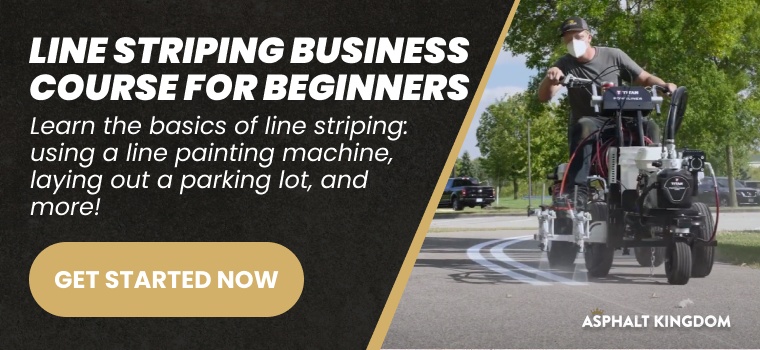Line striping is one of the very few businesses that has low set-up costs, is pretty easy to do, and is needed by nearly every business, offering a consistent demand. It's also a solid way to work outdoors, set your own hours, and make good money.
But hey — just wanting to do it isn’t enough, right? Just like any business, there are some hurdles to jump, like the banking and legal stuff — oh, and learning how to actually line stripe.
So how do you make it happen? Here is the complete, step-by-step guide to help you get started (and succeed) in the business.
P.S. This is a bit of a long ride, but that’s for a very good reason — we want to make sure you have everything you need to know to do this the right way, the first time. By the end of this article, you’ll know exactly how to start (and keep) a lucrative line striping business. Stick with us for the ride, but only if you're serious about this.
Start Your Line Striping Business Here
So you're pumped to start a line striping business. You're ready to buy line striping supplies, register your business, get your first customers, and get the measuring wheel rolling. Trust us, we’ve been there, and it’s a lot of fun.
But hold your horses — it’s still a business, which means it can be easy to mess up if you don’t do your homework. You can waste money on the wrong equipment or mess up a job by not following the right specs. Even worse, it's also so easy to go right ahead and offer line striping without acquiring the right permits, bank account, or insurance first.
The problem is, that these are not minor mistakes. Purchase the wrong type of equipment, supplies, or tools, and you risk losing not just your money, but also your reputation as a new line striper.
And if you offer your line striping services without having proper knowledge about parking lot striping layout, you might as well say goodbye to your line striping career before it even takes off.
So before you take the plunge, make sure to do your homework first!
The things you need to know about this business are divided into two sections:
1. The actual line striping
2. Business management.
Let’s go through both.
How to Learn How to Line Stripe
As for the actual line striping process, the good news is the internet is a great resource for parking lot line striping and business management information. If you're looking for a complete guide on line striping, then check out Asphalt Kingdom's Line Striping Course.
In this course, you'll learn pretty much everything about line striping, including the different pieces of equipment and supplies you need to jumpstart your parking lot striping business. This is also your complete guide to proper asphalt surface preparation, how to create a parking lot layout, and how to price your line striping services.
Okay, that's the line striping part of the business. Now, let's dive into the business management aspect.
Related: ADA Handicap Parking Requirements & Cheatsheet
How to Start a Line Striping Business
1. Look for Ways to Fund Your Business
Alright, you’ve got the knowledge, but now you need the cash to get your line striping business off the ground. Start-up money is crucial for buying the right equipment, paying your bills, and keeping things running smoothly.
Most small business owners dip into their own savings to get started. In fact, according to the Chamber of Commerce, 75 to 80% of small business entrepreneurs use their own money to fund their ventures. But if you don’t have the cash, that’s not the only way. Here are some other funding options:
- Asphalt Business Financing: Specialized loans for businesses like yours.
- Bank Loans: Traditional loans with various interest rates and terms.
- Credit Cards: Handy for smaller purchases, but watch out for high interest rates.
- Loans from Family and Friends: Just make sure to keep it professional to avoid any awkward Thanksgiving dinners.
- Angel Investors: These folks are looking to invest in promising businesses like yours.
- Government Grants: Free money! But they’re competitive and can be tough to get.
Each funding option has its pros and cons, so pick what works best for you. Check out this article on the different funding options available for you.
Quick tip: Be realistic about how much you need and what you can repay. The last thing you want is to start your business deep in debt.
Video: How to get started with a line striping business
2. Choose the Right Legal Structure for Your Line Striping Business
Alright, now that you’ve got some funding ideas, it’s time to get your business officially up and running. One of the first steps is choosing the right legal structure for your line striping business. This choice affects your taxes, liability, and how much paperwork you’ll need to handle.
Let’s break down the most common legal structures:
Line Striping Sole Proprietorship
As the name suggests, this structure means you’re the sole owner. It’s easy and cheap to set up, but there’s a big downside – you’re personally liable for any debts or legal issues. Your personal assets could be at risk if things go south.
Line Striping Partnership
If you’re starting the business with someone else, a partnership might be the way to go. There are two types:
- General Partnership: Both partners share the business responsibilities and liabilities.
- Limited Partnership: One partner has limited liability and isn’t involved in daily operations.
Line Striping Limited Liability Company (LLC)
An LLC offers liability protection for your personal assets, which is a huge plus. It’s more expensive and complex to set up compared to a sole proprietorship or partnership, but it’s often worth it for the added security.
Line Striping Corporation
A corporation is a more complex structure that offers the most protection for your personal assets and debts. It’s great for raising funds and offers business continuity even if one or more shareholders leave. The downside? It’s complicated to set up and involves double taxation – once on the corporation’s income and again when you pay yourself.
Each structure has its pros and cons, so think about what makes the most sense for your situation. If you’re unsure, it might be worth talking to a business advisor or attorney to help you make the best choice.
Quick tip: Choosing the right legal structure can save you headaches down the road, so take the time to get it right.
3. Do a Deep Dive into Business Taxes, Insurance, and Financial Statement Interpretation
There’s nothing more exciting than becoming your own boss, but running a business also means dealing with some not-so-fun stuff like taxes, insurance, and finances. However, understanding these elements is crucial to keep your line striping business above board and profitable.
Line Striping Business Taxes
You need to make sure your taxes are paid on time to avoid penalties. Depending on your legal structure, your tax obligations will vary:
- Sole Proprietorship and Partnership: You’ll report business income and expenses on your personal tax return.
- LLC and Corporation: These have different tax forms and potentially different tax rates. Talk to a tax professional to understand what you need to file.
Line Striping Insurance
Insurance is your safety net. It protects you from unexpected events that could otherwise sink your business. Here are the types of insurance you might need:
- General Liability Insurance: Covers accidents, injuries, and property damage.
- Commercial Property Insurance: Protects your equipment and property.
- Workers’ Compensation Insurance: Required if you have employees, it covers job-related injuries and illnesses.
- Commercial Auto Insurance: If you use a vehicle for business purposes, this covers damages and liability.
There are lots of insurance providers out there, but you can get trusted and proven insurance, for asphalt guys, by asphalt guys, if you need it (which you will).
Line Striping Financial Statements
Understanding your financial statements helps you keep track of your business’s health. Here are the basics:
- Income Statement (Profit and Loss Statement): Shows your revenue, expenses, and profits over a period.
- Balance Sheet: Provides a snapshot of your business’s financial position, including assets, liabilities, and equity.
- Cash Flow Statement: Tracks the cash coming in and going out, helping you manage liquidity, or how easily you can get access to cash.
Quick tip: You don’t need to go back to school to learn this stuff. There are plenty of books, eBooks, and online resources that can teach you the basics. Check out your local library or trusted online sources to get started.

Organized folders with a focus on a folder labeled with “Taxes”
4. Create a Solid Business Plan
It might be tempting to skip this part, but a business plan is essentially your company’s roadmap. It might sound complicated, but this document simply covers what services you offer, your business goals, market analysis, marketing strategies, financial projections, and contingency plans. Having a well-thought-out business plan can help you stay on track and measure your progress.
Here’s what you need to include in your business plan:
- Executive Summary: A brief overview of your business, including your mission statement and what you aim to achieve.
- Business Description: Detailed information about your line striping business, the services you provide, and what sets you apart from competitors.
- Market Analysis: Research on your target market, industry trends, and competitors. This helps you understand where your business fits and how you can stand out.
- Organization and Management: Outline your business structure and management team. If it’s just you, that’s fine — just detail your own experience and skills.
- Services or Product Line: Describe your line striping services in detail. Explain the benefits and why customers should choose you.
- Marketing and Sales Strategies: How you plan to attract and keep customers. This includes your pricing strategy, promotional activities, and sales tactics.
- Funding Request: If you’re seeking financing, detail how much you need, where the money will be spent, and how you plan to repay it.
- Financial Projections: Provide an overview of your financial goals. This should include projected income statements, cash flow statements, and balance sheets for the next few years.
- Appendix: Any additional information that could be useful, such as resumes, permits, or legal documents.
Quick tip: Don’t know where to start? The U.S. Small Business Administration has a great guide for writing a business plan, or you can hire a professional from Fiverr or Upwork to help you out.

Entrepreneur creating business plan.
5. Come Up with a Catchy Line Striping Business Name
Choosing the right name for your line striping business is more important than you might think. A good name is memorable, easy to spell and pronounce, and gives potential customers a positive impression of your business.
Here are some tips for picking a great business name:
- Reflect Strength and Quality: Choose a name that represents reliability and professionalism. Words like “Precision,” “Elite,” or “Pro” can add a sense of quality.
- Keep It Simple: Avoid complicated names that are hard to spell or pronounce. Simple names are easier for customers to remember.
- Make It Unique: Do a quick Google search to make sure your chosen name isn’t already in use. You want to stand out, not blend in.
- Leave Room for Growth: Avoid names that are too specific to line striping. You might want to expand your services in the future.
- Check Domain Availability: Make sure the domain name for your business is available. Having a matching website URL is important for online marketing.
Related: What Are the Standard Dimensions of a Parking Space?
Quick tip: Once you’ve chosen a name, register it and secure the domain name as soon as possible. This way, you won’t risk someone else grabbing it before you do.
6. Find the Best Line Striping Supplier for Your Business
You might be the best line striper in town, but if your supplier can't keep up, neither will your business. Having a reliable supplier is crucial for maintaining quality and meeting deadlines. Here’s what to look for:
Quality of the products
Make sure that the supplier offers only the best oil-based and water-based traffic paints. If possible, purchase a bucket of paint to test it first before you commit to one supplier.
Reliable reputation
Do some research. Is the supplier highly recommended by other line stripers? Do they have a solid track record in the industry? A supplier with a good reputation is less likely to let you down. These are just some of the questions you need to ask before you commit to a particular supplier.
Capacity
Is the supplier able to deliver multiple pallets of oil-based paint at the drop of a hat? If not, then it's better to skip them than lose money on your business because you run out of supplies during a big job.
Secure website
If you prefer ordering online, ensure the supplier’s website is secure. Look for HTTPS in the URL, read their privacy policy, and make sure they have a valid address and phone number listed. Lastly, if the prices are so low that it's too good to be true, then it probably is.
Fast delivery
Make sure that the supplier can deliver quickly, especially during the peak season. If there are supply or equipment inventory issues, is the company transparent about when those items are in stock and will be delivered?
Quick tip: It’s better to pay a bit more for a reliable supplier than to risk your business on a cheaper but unreliable one.
Related: Striping Machine Handbook
7. Get Multiple Business Bank Accounts
Using your personal bank account for your business might seem convenient, but it can lead to a financial mess. Keeping your personal and business finances separate is crucial for tracking your income, expenses, and overall financial health. Here’s how to do it:
- Income Account: This is your primary business account where all your earnings are deposited. It helps you keep track of your total income.
- Operating Expenses Account: Use this account to pay for day-to-day expenses like supplies, equipment, payroll, and insurance. This keeps your spending organized.
- Net Profit Account: After covering all your expenses, transfer the remaining money here. This account helps you track your profits and reinvest in your business.
- Taxes Account: Set aside a portion of your income for taxes in this account. It prevents any nasty surprises when tax season rolls around.
- Compensation Account: Use this account to pay yourself a salary. This ensures you’re compensated regularly and helps maintain personal financial stability.
Quick tip: Automate transfers between these accounts to save time and to have consistency. Many banks offer this service, and it helps you stay disciplined with your finances.
Check out this Asphalt Kingdom blog to learn more about the different business bank accounts you need to acquire.
Related: Line Striping Tips and Tricks from the Pros
8. Have a Plan in Place for Colder Months
Line striping is mostly a warm-weather gig, so what’s your plan when it’s too cold to stripe? You need to think ahead to ensure a steady income throughout the year. Here are some quick ideas:
Winter Services:
- Winter Pothole Repair: Potholes are common in winter. Offering repair services can keep your business busy.
- Snow Removal: If you get snow, this is a great way to keep earning. Invest in the right equipment and market your services.
- Indoor Stenciling and Line Striping: Some facilities need indoor line striping year-round, providing steady income.
- Winter Tree Maintenance: Branch out into tree maintenance during colder months.
Quick tip: Promote your winter services early. Clients will appreciate knowing they can rely on you year-round.
Check out this Asphalt Kingdom blog to learn about winter money-making ideas for asphalt contractors.
Get Work All Year Long: Add Pothole Repair To Your Business
Where to Next With Asphalt Kingdom
Hey — you got through that whole thing — you must be serious about this, which is a great sign of success. You’ve now pretty much got everything you need to make sure you start your line striping business the right way, and to make sure you make a good amount of money.
If you need help choosing the right traffic paint or the best line striping machine, just give us a call at 1-866-399-5562. You can also use our asphalt traffic paint calculator to figure out the amount of paint you’ll need for your very first project.
Want expert business advice? Check out our Asphalt Coaching
Frequently Asked Questions
Q: What are the essential steps to start a line striping business?
A: To start a line striping business, you need to learn the ropes by understanding the technical aspects of line striping and the business management side. Secure funding, choose the right legal structure, understand business taxes and insurance, create a solid business plan, come up with a catchy name, find a reliable supplier, set up multiple business bank accounts, and plan for year-round services.
Q: What equipment do I need to start a line striping business?
A: To start a line striping business, you'll need a reliable line striping machine, traffic paints (both oil-based and water-based), a measuring wheel, stencils for various markings, and safety gear like high-visibility vests and cones. Investing in high-quality equipment ensures durability and professional results.
Q: What legal structure is best for a line striping business?
A: The best legal structure for a line striping business depends on your specific needs. A sole proprietorship is easy to set up but offers no personal liability protection. An LLC provides liability protection and is relatively simple to manage. For those looking to expand and raise capital, a corporation might be the best choice, despite its complexity and potential for double taxation.
Q: How can I keep my line striping business profitable in winter?
A: To keep your line striping business profitable during the colder months, consider offering additional services like winter pothole repair, snow removal, and indoor line striping. Promote these services early and consider maintenance contracts to ensure a steady income throughout the year.
Q: What are the best funding options for a new line striping business?
A: Funding options for a new line striping business include using personal savings, applying for bank loans, using credit cards, seeking loans from family and friends, attracting angel investors, and applying for government grants. According to the Chamber of Commerce, 75 to 80% of small business owners use their own money to fund their ventures.










